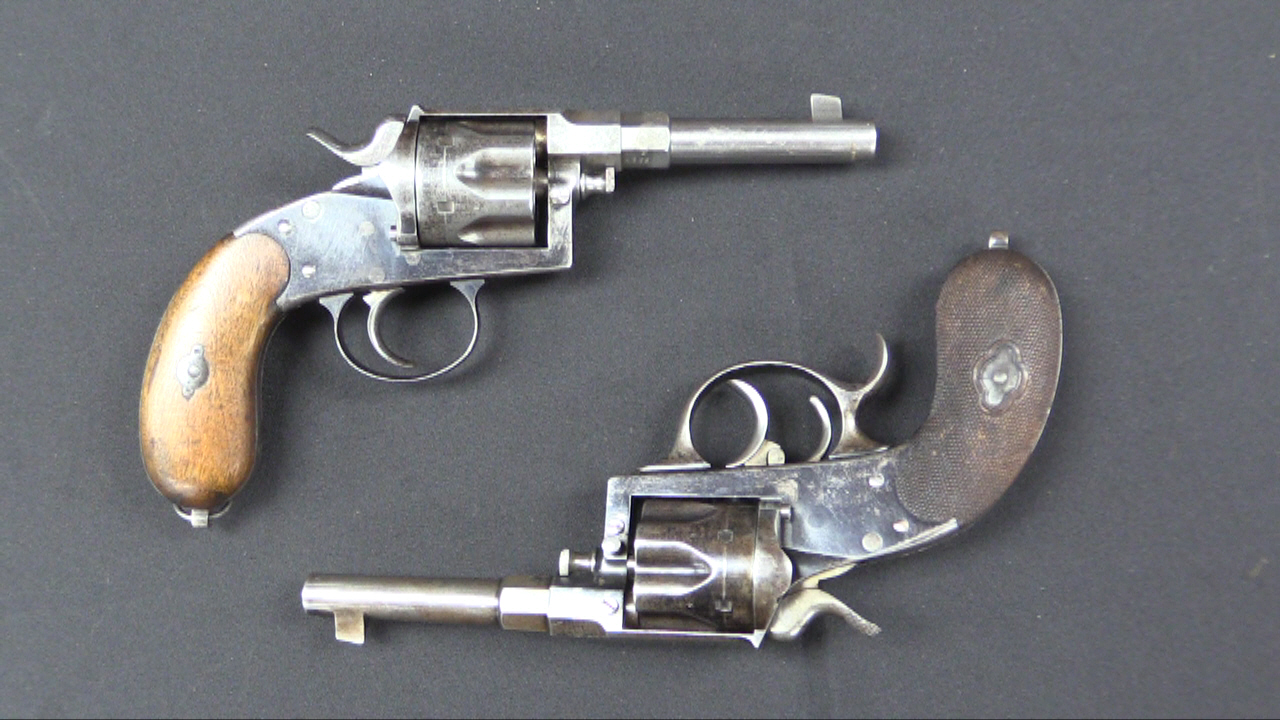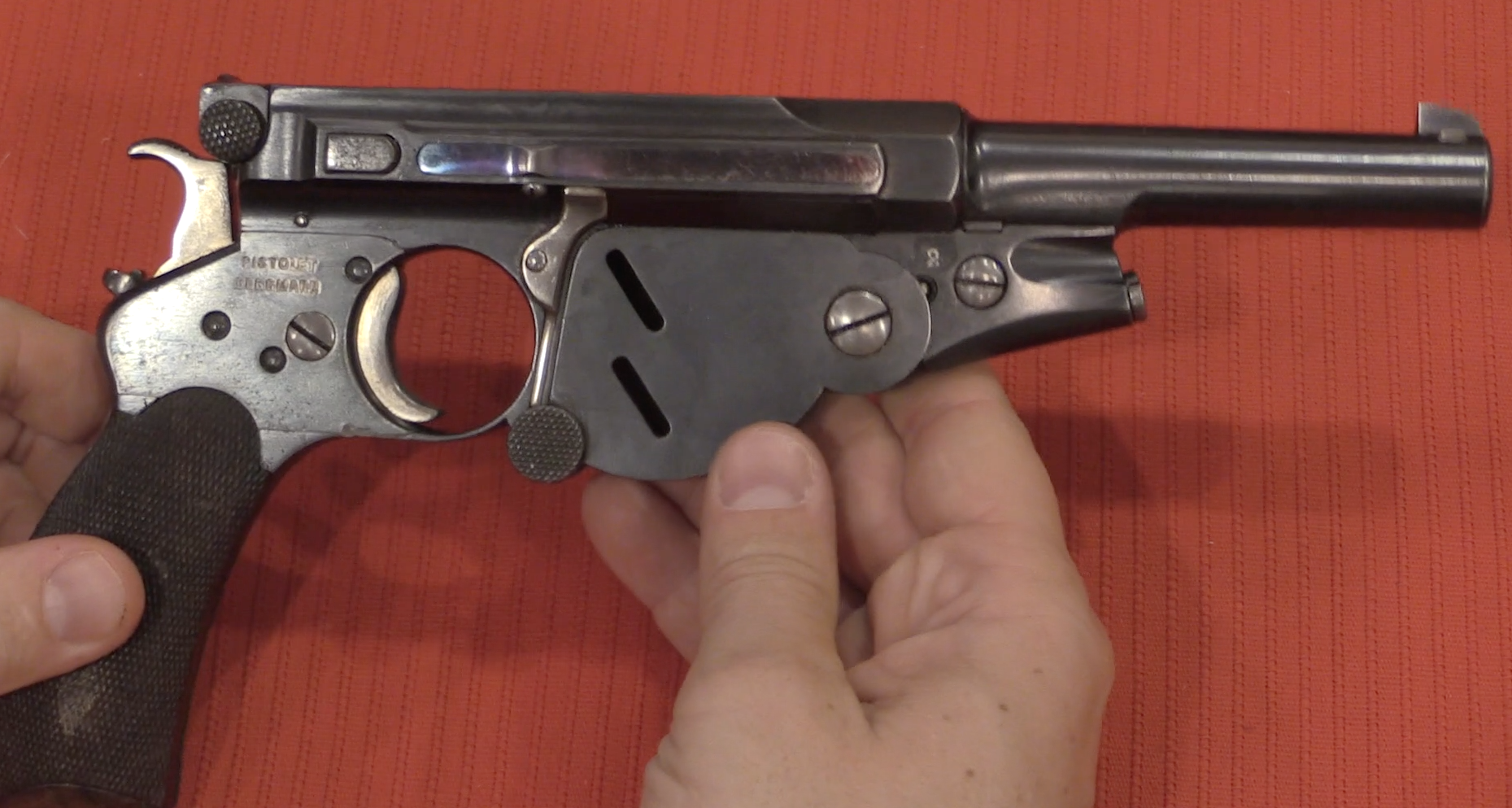The FG-42 was specifically made with a scope attachment on every rifle, and intended to serve as a marksman’s or sniper’s rifle. But how much of that actually happened during World War Two? And was the FG-42 actually suited to a sniper role?
Related Articles

Revolver
Model 1883 Reichsrevolvers at RIA
It did not take long for some of the handling problems of the model 1879 Reichsrevolver to become apparent, and the result was a redesign to the model of 1883. These new guns retained the […]

Bergmann
Bergmann Transitional No 4/5 Pistols
Another pair of transitional Bergmann transitional prototypes today, this time ones that sit between the 1896 and 1897 designs (No2/3/4 and No5). One of these is basically an 1896 frame with an 1897 upper assembly […]

Bolt Action Rifles
German Mauser Obrez Pistol
From the collection of the Deutsches Historisches Museum, a reader named James found an example of an Obrez pistol made on a Mauser K98 rifle action. This apparently was made by Czech partisans during World […]

Seems like wishful thinking. Probably get the same/similar results dropping one on a BAR (at least it had a bipod).
Seems a little too mobile to be an effective sniper.
“(…)Probably get the same/similar results dropping one on a BAR (at least it had a bipod).”
Hard to say without conducting real test, however BAR has feature which suggest it would be ill-suited for that namely, as
https://modernfirearms.net/en/machineguns/u-s-a-machineguns/browning-m1918-bar-eng/
put its:
The BAR always fired from the open bolt to avoid cook-offs.
Even worse: most versions did only shoot fully automatic. Onlyy a few commercial models had a semi setting. Though the latter with training should give passable results shooting for precision as open bolt operation increases lock time. That is the delay between pulling the trigger and the cartridge’s ignition. The heavy weight of the BAR should keep it steady enough while the bolt moves into battery. Of course far from perfect, but all the semi-autos from WW2 were not that great precision shooters either.
Makes me wonder if some GI had cobbled together a BAR with a scope during the war or in Korea? The US Army Ordonance seems to have seen the M1918A2 more like a light MG, so they probably never looked into that direction.
Never heard of rigging a scope to one, I think that’d probably be difficult just because of the general design and shape of the BAR. You’d probably need to drill and tap the side of the receiver to scope a BAR, not worth the effort especially as the M1C/M1D Garands started getting around. I have heard that they were considered a handy anti-sniper weapon in the Pacific and Korea though, just for being accurate and mobile enough to fire off a few bursts at likely hides without having to drag around a 1919.
And I’ve never been able to work out how much it got used, but the M1918A2 did have that fire rate selector mechanism. Heard it wasn’t that reliable, but there was a switch using a buffer in the stock that could drop the ROF on the M1918A2 – numbers are a bit fuzzy, but “low” was in the 350-400RPM range and standard was more like 550-650. Should be fairly easy to squeeze off single shots or doubles on low without kicking too far off-target.
I fired a 1918A2 at a machine gun shoot. I don’t know what rate it was set on, but I was easily able to fire single shots and two shot bursts. Loved it! Recoil from the bipod was negligible.
Really?!
I don’t believe you.
It had to be a semi-auto, and a full auto rifle.
Technical issue; the video seems to lose focus a few times; it looks like Ian’s hand movements change what the camera is focusing on, maybe?
As a completely unrelated aside; I’ve always wondered why he wears long sleeve shirts but pushes the sleeves above his elbows. Wouldn’t it be easier to wear a short sleeve?
Curiosity, no more.
He does wear short sleeve polo shirts now and then. Forgotten Weapons logo on them, of course. Available through his web site.
Because when you have long sleeves, you can push them up or roll them back down at your leisure. It goes from very hot to very cold in the desert, doubly so if it’s winter and you’re going from outside to inside.
Now is the time to shoot a few groups with that FG, off the bench and off the bipod. Yes, and a few more testing scope vs. iron sights. Heck, I’ll even volunteer to shoot ’em.
I don’t think the FG42 necessarily fits into any of the categories it was shoehorned into; rather, it rises above categories completely. It wasn’t meant to be a pure LMG; it wasn’t meant to be a pure infantryman’s rifle; it wasn’t meant to be a real sniper’s weapon; it wasn’t meant to be an SMG, either–But, it was supposed to serve as a weapon that could do credible service in all of these roles as tactical requirements arose.
It’s like the Swiss Army knife; you need to do a lot of work with Phillips bit fasteners, then the SAK ain’t what you want. You want to be using an actual screwdriver in the appropriate size; however, comma… If you’re not carrying your master mechanic’s toolbox around with you, and all you have is the SAK, well… It’ll serve. Same-same with every other blade/tool on that SAK; none of them are ideally suited to the purpose, but they’ll do when that’s all you have. And, for a Falschirmjager, that’s the sort of general-purpose multi-role individual weapon they needed.
Sort of a Jack of all trades master at none sort of thing. Forward thinking for the time and I certainly wouldn’t have complained about being issued one that’s for sure.
Well said, Kirk.
So what we have is a rifle that can theoretically adapt to changing conditions and preferred user requirements. That sounds awfully familiar. It won’t excel at any particular task, but for the paratroopers, having a rifle that can be carried on the way down from the transport plane beats having to run around looking for the parachuted weapons canister while armed with little more than a utility knife and a Walther PPK (or a P38 if you’re lucky). Oh, and did I mention there’s a chance the other team has captured the canister and taken advantage of its contents?
I could be wrong.
Yup, Kirk pretty much nails it. Especially desirable was the fully automatic capability to give the German Fallschirmjäger more firepower after hitting the ground.
Overall the description actually reads very much like the role description of an assault rifle, which was the concurrent independent development of the Heer. A bit ironically the yugoslavian paras deployed the MP43/44/Stgw.44 for quite some time after the war until the yugo-AKs were put into service.
Well, it was planned and executed as a paratrooper-rifle. First and foremost. An elite rifle for an elite troop.
They certainly included the scope as an option so that it could be used LIKE a marksman-rifle. (Which became an issue later when they needed much more such rifles.)
And, sure, you can also do “sniper-work” with a marksman-rifle. But I very much doubt that it was ever intended that way. And it certainly wasn’t great in that role either.
“(…)very much doubt that it was ever intended that way(…)”
https://military.wikia.org/wiki/FG_42 mention specification LC-6 which spawned this weapon, does anybody access to it in full and original (Deutsch) form?
The Dugelby/Stevens book has what claims to be a translation of LC6. Basically it says make an FG42 – a dimension and weight-limited 7.92×57 select fire weapon. It’s brief; it includes silly things like “be free of stoppages”. It includes an optical sight requirement without saying whether it was intended for general, marksman, or sniper use. The absence implies general use.
It is put in the context of Hitler, post-Crete, deciding against para-only operations. Instead the paras would be the first and pointiest bit of the spear, but rapidly reinforced/replaced by regular infantry. Which is why they wanted something droppable on the person that had range and firepower, to keep them effective until the regular forces turned up, recognising that ammo would be the key issue and would run out quickly.
Hence my previous question on whether they had a plan for how to fight at the most basic tactical levels, in those, I guess, 24-48 hrs, when mostly armed with FGs.
Of course, that never happened. But if they didn’t have a concept of how to use a section armed entirely with FGs, then this is a rare example of inventing and adopting a weapon not to fit a defined tactical concept, but because of what it was not (SMG, Sturmgewehr, K98, LMG) and then presumably inventing the tactics once it was available.
The FG-42 was tested in Aberdeen Proving Ground, in the spring of 1946.
The accuracy test showed 6.34″ with an iron sight and 5.79″ with a optic at 100 yards. In a circle containing 10 out of 10 shots.
The shooting was carried out with cartridges from the remnants of the Chinese order, of a rather dubious quality.
For comparison, under the same conditions, the acceptance accuracy for M1 Garand was 5″ and for M14 was 5.5″ at 100 yards is quite a good result.
I was in a DCM affiliated rifle club in the 1960’s, using issued Garands. Mostly standard issue, but we had a couple of National Match versions. The ammo was mostly M-2 ball from the early 1950’s. You just explained it was difficult to hit the 5 ring, and the V ring was exceptional. I finally went with a 1903 Springfield set up with aperture sights, and handloads. My scores went way up.
Wouldn’t it have been a lot simpler to make a better parachute. Why not copy a British parachute that had an attached weapons pack.
Installed base issue, really. They’d started out with a parachute from the WWI balloonist corps, and the initial jumps were done from aircraft with internal wells, which required you go out face-first and without much gear. Once on that path, getting off of it would have required re-training, and entirely new equipment. Limited resources meant… They were stuck with it the way we’re all stuck with QWERTY.
Or, so my memory tells me. There’s a book out there, or a study discussing this issue, but I’ll be damned if I can find it.
They may not have had an aircraft with a door big enough. Easier to drop stuff separately than to redesign and make airplanes.
It is believed that this design of the parachute was chosen for a number of reasons.
First. Such a simple (and therefore cheap), uncontrollable, the parachute opens up faster, therefore it allows a drop to be carried out from a lower altitude.
Second. Such a parachute has a minimal area, which reduces the time a paratrooper spends in the air.
Third. The inability to choose the landing site does not allow the paratroopers to scatter arbitrarily from the point of release, out of unwillingness to get into the water or onto a tree. And that means being too far from the cargo package.